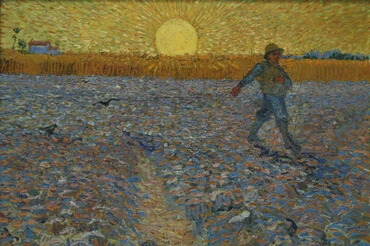A "field" in the Bible usually represents the Lord's church, and more specifically the desire for good within the church. It's where good things start, take root, and grow. When you have a desire to be a good person and to do good things, the natural first questions are "What does that mean?", "What should I do?", "What can I do?". You look for ideas, concepts, direction. Once you figure out something you want to do or a change you want to make in yourself, you seek specific knowledge. If you want to volunteer at a food pantry, say, you'd need to know whom to call, when they need help, where to go, what to bring. Armed with that knowhow, you're ready to get to work. That process could be compared to food production. You start with a field -- which is that desire to be good. Then you plant seeds -- those ideas and concepts. Those seeds sprout into plants -- the specific facts and knowledge needed for the task (easily seen in the food pantry example, but also true with deeper tasks like "being more tolerant of my co-workers" or "taking more time for prayer," or "consciously being a more loving spouse"). Finally, those plants produce food -- the actual good thing that you go and do. The Writings also say that in a number of cases a "field" represents the doctrine, or teachings, of the church. This sounds markedly different. The desire for good is emotional, a drive, a wanting; doctrine is a set of ideas. But for a church to be true, its doctrine must be centered on a desire for good, and must lead people toward doing what is good. So sound doctrine is actually closely bound up with the desire for good.
Arcana Coelestia #2970
2970. 'Which was in Machpelah, which was before Mamre' means the nature and extent of regeneration. This is clear from the meaning of 'Machpelah' as regeneration by means of the truth of faith, and from the meaning of 'Mamre' as the nature and extent of it. When the word 'cave' is combined with the name Machpelah - that is, when the expression 'the cave of Machpelah' is used - faith enveloped in obscurity is meant by it, 2935. But when Machpelah is mentioned by itself, and then followed by the phrase 'the field and the cave', regeneration is meant, for 'the field and the cave' means the good and truth of faith by means of which regeneration is accomplished. Furthermore Machpelah was a plot of land in which also there was a grave, which means regeneration, 2916. But 'Mamre', being Hebron, as stated below in verse 19, or 'in Hebron', as stated in Genesis 13:18, here means nothing else than the particular kind of a thing and the measure in which this exists. In this case the kind of regeneration and the measure of it is meant when 'Mamre' is linked with 'Machpelah'; the kind of Church and the degree to which it exists when 'Mamre' is linked with 'Hebron'; and the kind of perception and the measure of the same when 'Mamre' is linked with 'the oak-groves', as in 1616. Thus Mamre merely defines the state of the thing, for it was a place where Abraham dwelt, Genesis 13:18, and where Isaac dwelt and to which Jacob came, Genesis 35:27.







